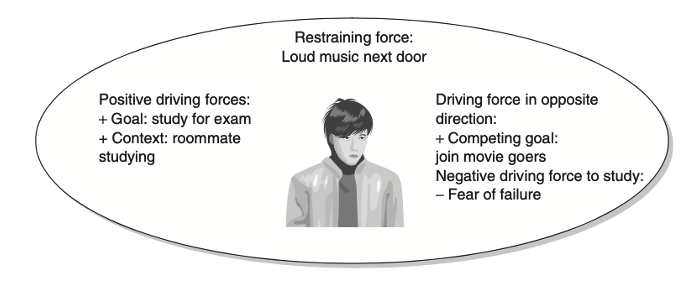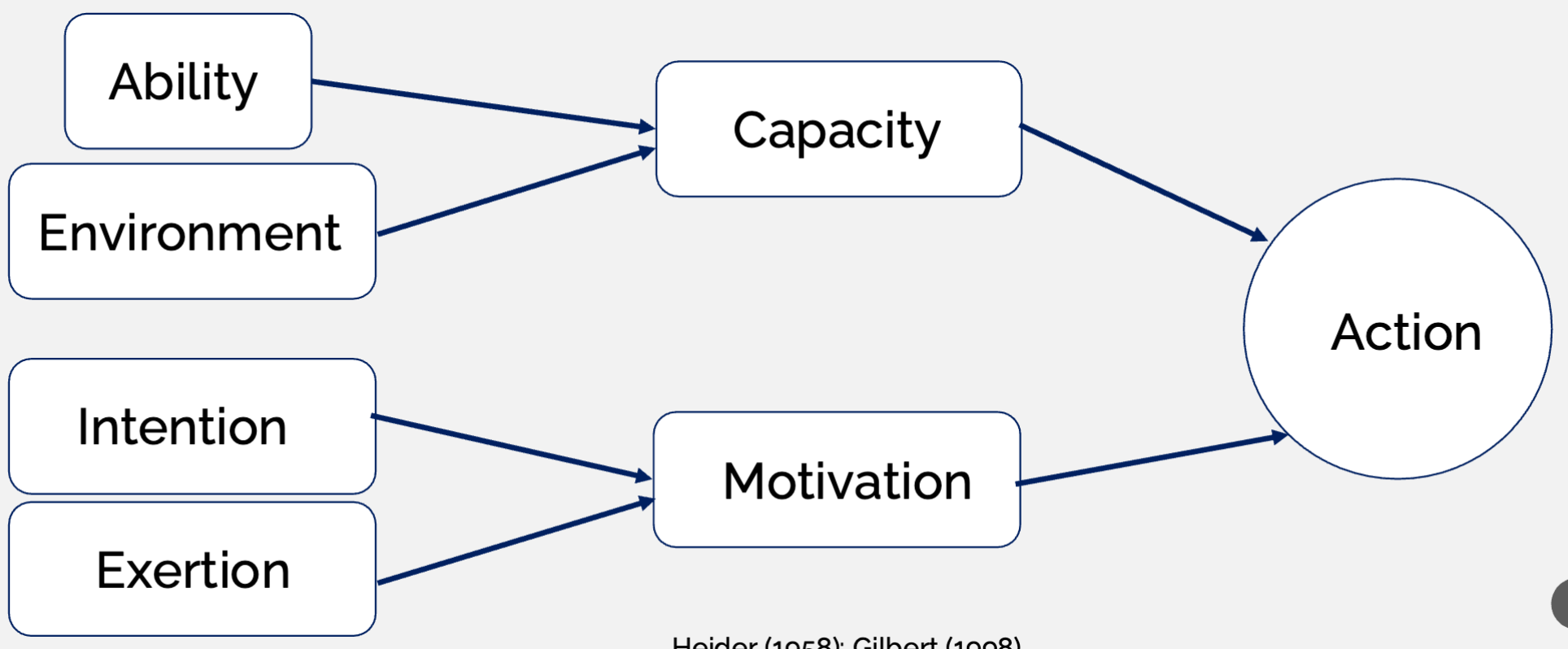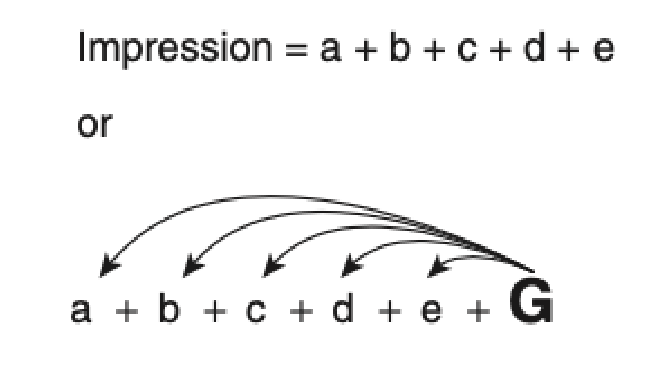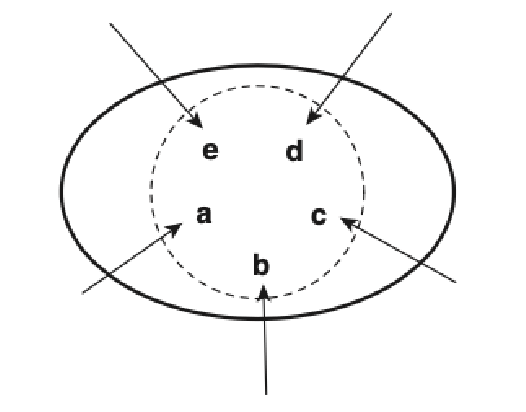PSY326: Social Cognition
1/73
Earn XP
Description and Tags
Name | Mastery | Learn | Test | Matching | Spaced |
|---|
No study sessions yet.
74 Terms
social cognition
how people make sense of others and themselves
social thinker/perceiver model
explains connections between motivations and cognition
consistency seeker (social thinker model)
we like consistency and think about our behaviours to avoid cognitive dissonance
naïve scientist (social thinker model)
we think we are rational and analyze situations
cognitive miser (social thinker model)
we have limited cognitive resources and use shortcuts to save them and to think quickly
motivated tactician (social thinker model)
we think before we act; the goals of an interaction influence what cognitive strategies we use
activated actor (social thinker model)
we use automatic processes to survive and thrive in social situations

psychological field
the influence of the (social) environment as perceived by the individual on cognition, affect, and behaviour; determined by their needs, beliefs, motivation, and interpretation of the world
dual-process models
models that divide cognition into binaries, usually one conscious and one unconscious
automatic (X-system) processing
reflexive, quick information processing that can be rooted in survival or heuristics
controlled (C-system) processing
deliberate, slow information processing that can incorporate knowledge and values
Bargh’s four criteria of automaticity
A: outside of awareness
I: lacking intentionality
C: lacking control
E: efficient
full automaticity
goal-independent responses that satisfy the four criteria of automaticity
subliminal priming
priming via sensation without perception; extremely hard to empirically test
conscious priming
priming via perception of a stimulus with unawareness of its effect
conceptual priming
activation of a concept in one’s mind
affective priming
activation of an emotional state in one’s mind; doesn’t replicate uniformly
behavioural priming
activation of a concept that directly affects behaviour; only replicated by Bargh
accessibility
the extent to which a piece of information can be brought into awareness
proceduralization
the development of automaticity with practice (e.g., riding a bike); also applies to cognition (e.g., judgments)
goal-inconsistent automaticity
when a person’s own unwanted responses are governed by cognitive factors outside of control or awareness (e.g., “don’t think of a pink elephant”)
rebound effect
the increased accessibility of a stereotype due to not wanting to think about it
requirements for controlled processing
intent (attention and resources to reject the automatic response) and full control (awareness to inhibit automatic associations)
three-stage memory model
encoding → storage → retrieval
selective attention
not everything captures external (stimuli) or internal (mindfulness) attention
factors for social salience
being novel
standing out
being unusual/against expectations for that person
being unusual for that person’s social category
being unusual for people in general
being goal-relevant
dominating the visual field
being instructed to observe
self-concept/self-construal
our collected beliefs about ourselves; affected by treatment from others, cultural activities, roles, personality traits, and our private/presenting selves
working self-concept
the currently active aspect of the self-concept, usually determined by situational norms, that influences ongoing thought and behaviour (e.g., in class, the “student” aspect is active)
relational self
the ways we characterize ourselves when with another person that influence our emotions and behaviours with them; provides stability and variability
self-concept consistency
internal (few conflicting thoughts/beliefs), temporal (same over time), and cross-role (same between situations) consistency
self-schema
information that quickly comes to mind that represents the self’s qualities in a given domain; strong yeses or nos to questions about the self are self-schematic, but unsure answers are not
self-esteem
the evaluation we make of ourselves in our mental representation of the self
sociometer theory
proposes that self-esteem reflects what you believe other people think about your worth as a person and can therefore be influenced by others or by yourself
contingency of self-worth
a selected domain on which self-esteem is based (e.g., academic performance); high contingency individuals have lower self-esteem after receiving a rejection
independent self-construal
emphasizes stability, internal traits (abilities, thoughts), uniqueness, and directness; uses others to compare/reflect on the self; bases self-esteem on the ability to express oneself
interdependent self-construal
emphasizes social context, flexibility, public traits (roles, relationships), fitting in, and indirectness; uses others for self-definition; bases self-esteem on the ability to maintain harmony
self-evaluation
assessment of self-esteem, self-concept, introspection, etc. motivated by a desire for knowledge about the self, a desire for consistency, self-improvement (getting better), and self-enhancement (feeling good about ourselves)
social comparison theory
we learn about ourselves by comparing ourselves to other people
attribution
how people infer causal explanations for others’ actions and mental states (“why would they do this?”)
controlled attribution
attribution which does not use shortcuts; common when it’s important to get the attribution right or after unexpected or negative events
mind perception
inferences about the mental states of others including their beliefs, intentions, desires, and feelings; people tend to project their own minds onto similar others and are over-enthusiastic to do so
cause-effect relations
a set of principles that define what makes an attribution generally (but not always) accurate
cause precedes effect (cause-effect relation)
the cause comes before the effect
temporal contiguity (cause-effect relation)
factors that occur immediately before an effect are more plausible to be the cause then those occurring much earlier
spatial contiguity (cause-effect relation)
factors that are nearby are more plausible than those far away
perceptual salience (cause-effect relation)
stimuli that are salient and easily perceived are more likely to be perceived as causal than stimuli in the background (e.g., temperature is a background stimulus)
causes resemble effects (cause-effect relation)
people assume big effects are produced by big causes (and little effects by little causes)
fundamental principles of attribution theories
generic: people use cause-effect relations in most places of life
minimal determinism: people infer causality in relatively simple rulesets (parsimony)
motivational point of departure: people must have a resource to search for causes (commonly unexpectedness/negativity)
attribution formation
the explanation for an action comes from whether it’s possible and has a reason to be done

correspondent inference theory
proposes we seek to identify intentions underlying behaviour in order to infer the actor’s dispositions, which informs how we act around them in the future
dispositional attribution
an inference about behaviour as due to beliefs, traits, and abilities (i.e., who somebody is)
situational attribution
an inference about behaviour as due to external factors
covariation model
when and how people seek to validate causal attributions
consensus
covariation of a person’s behaviour across different people in a similar situation
distinctiveness
covariation of a person’s behaviour across different situations
consistency
covariation of a person’s behaviour across time (similar behaviour every time the situation occurs)
self-perception theory
people infer their own attitudes from their behaviours, especially when preexisting attitudes or internal cues are weak
extrinsic motivation
behaviour attributed to external factors
intrinsic interest
behaviour that is done for minimal reward, therefore attributed to internal factors
fundamental attribution error
the tendency to attribute another person’s behaviour to dispositional causes (more salient than background factors); domain-specific, sensitive to motives/cultures, and more likely for strangers
actor-observer effect
people explain other people’s behaviour as due to dispositional factors but their own behaviour as due to situational factors (especially when the event is negative)
self-serving attributional bias
the tendency to take credit (dispositional) for success and deny responsibility (situational) for failure
group-serving bias
ingroup members attribute positive group actions to ingroup qualities and distance themselves from the group after negative group actions
person perception
the perception of others which is different than the perception of things because:
people intentionally influence the environment
people perceive back
impressions of others are based on the self
social stimuli can change when being watched
non-observable attributes (CAB) are vital
people change over time more than objects
it’s harder to evaluate the accuracy of cognitions about people than objects
people are complex
people are more interesting to figure out
thin-slice impression study
compared impressions of an instructor between participants who watched 30 seconds of clips and participants who had an entire semester with them; found that the impressions were relatively similar
Asch’s model of person perception
compared responses to two identical lists of traits (except warm/cold); found that central traits affect perception of other traits
central trait
a characteristic that has a very strong influence on the perception of other traits (e.g, warm/cold)

algebraic model (Asch’s person perception)
each trait is evaluated separately and combined into an overall summary (outdated)

configural (holistic) model
overall impressions are formed by changing individual traits to fit overall context, schemas, and central traits
chronically accessible concepts
how people habitually code other people, especially particular trait dimensions (e.g., attractiveness as being the first thing you notice); influenced by family, culture, survival, and occupation
implicit theories of impression formation
behaviour is predicted based on prior assumptions about the person; divided into entity theory and incremental theory
entity theory
the assumption that personal qualities (e.g., intelligence) are mostly fixed and that people don’t change much between situations
incremental theory
the assumption that personal qualities are changeable and context-dependent
Molden et al.’s implicit theory study
participants watched a video of a woman acting anxiously; under cognitive load, entity theorists are more likely to attribute to disposition even if the situation was stressful and incremental theorists are more likely to attribute to situation even if the woman was an anxious person